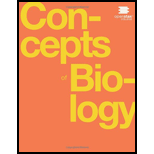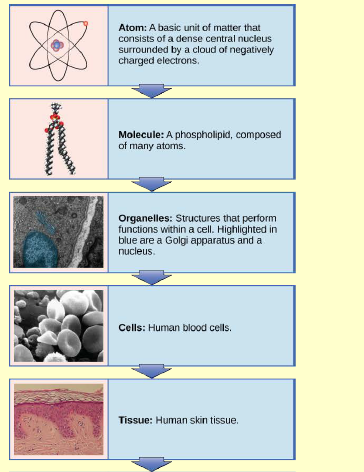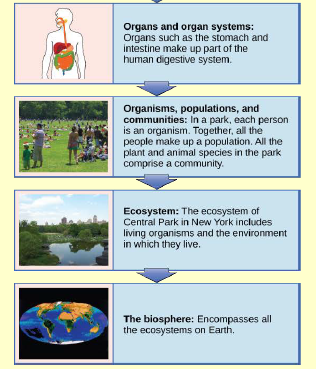
Concept explainers
Figure 1.8 Which of the following statements is false?
A. Tissues exist within organs which exist within organ systems.
B. Communities exist within populations which exist within ecosystems.
C. Organelles exist within cells which exist within tissues.
D. Communities exist within ecosystems which exist in the biosphere.



Introduction:
Biological organization is a definite series of biological structures and systems that defines life. In it, each level represents the organizational complexity. Every level is termed as the object, and each object is composed of the previous level's object.
Answer to Problem 1ACQ
Correct answer:
Among the answers given, the correct answer is option (b), communities exist within population which reside in the ecosystems.
Explanation of Solution
Explanation/justification for the correct answer:
Option (b) is communities exist within population which resides in the ecosystem. Many populationtogether form the communities. So, communities do not form the population, but populations form the communities. Further, ecosystem is composed of many communities not of populations. Hence, this option is correct.
Explanation for incorrect answer:
Option (a) is tissues exist within organs which exist within organ system. The living body is composed of many organs which together forms the organ system. Further, the organs are composed of various tissues. So, tissues form the organs and organs in turn forms the organ system. hence, this option is incorrect.
Option (c) is organelles exist in cells andthey form the tissues. Cell is the fundamental unit of the life. Cell contains many organelles in its cytoplasm and their function is to maintain life by processing metabolism. Many cells then form the tissues. Hence, this option is incorrect.
Option (d) is communities form the ecosystem which exist in biosphere. Different communities come together to form the ecosystem. Many ecosystems combine to form the biosphere. Hence, this option is incorrect.
Option (b), communities exist within population which reside in the ecosystems, is the correct answer.
Want to see more full solutions like this?
Chapter 1 Solutions
Concepts of Biology
Additional Science Textbook Solutions
College Physics: A Strategic Approach (3rd Edition)
Campbell Biology: Concepts & Connections (9th Edition)
Campbell Essential Biology (7th Edition)
Biology: Life on Earth (11th Edition)
Microbiology: An Introduction
Human Anatomy & Physiology (2nd Edition)
- Which of the following is not a DNA binding protein? 1. the lac repressor protein 2. the catabolite activated protein 3. the trp repressor protein 4. the flowering locus C protein 5. the flowering locus D protein 6. GAL4 7. all of the above are DNA binding proteinsarrow_forwardWhat symbolic and cultural behaviors are evident in the archaeological record and associated with Neandertals and anatomically modern humans in Europe beginning around 35,000 yBP (during the Upper Paleolithic)?arrow_forwardDescribe three cranial and postcranial features of Neanderthals skeletons that are likely adaptation to the cold climates of Upper Pleistocene Europe and explain how they are adaptations to a cold climate.arrow_forward
- Biology Questionarrow_forward✓ Details Draw a protein that is embedded in a membrane (a transmembrane protein), label the lipid bilayer and the protein. Identify the areas of the lipid bilayer that are hydrophobic and hydrophilic. Draw a membrane with two transporters: a proton pump transporter that uses ATP to generate a proton gradient, and a second transporter that moves glucose by secondary active transport (cartoon-like is ok). It will be important to show protons moving in the correct direction, and that the transporter that is powered by secondary active transport is logically related to the proton pump.arrow_forwarddrawing chemical structure of ATP. please draw in and label whats asked. Thank you.arrow_forward
- Outline the negative feedback loop that allows us to maintain a healthy water concentration in our blood. You may use diagram if you wisharrow_forwardGive examples of fat soluble and non-fat soluble hormonesarrow_forwardJust click view full document and register so you can see the whole document. how do i access this. following from the previous question; https://www.bartleby.com/questions-and-answers/hi-hi-with-this-unit-assessment-psy4406-tp4-report-assessment-material-case-stydu-ms-alecia-moore.-o/5e09906a-5101-4297-a8f7-49449b0bb5a7. on Google this image comes up and i have signed/ payed for the service and unable to access the full document. are you able to copy and past to this response. please see the screenshot from google page. unfortunality its not allowing me attch the image can you please show me the mathmetic calculation/ workout for the reult sectionarrow_forward
 Biology 2eBiologyISBN:9781947172517Author:Matthew Douglas, Jung Choi, Mary Ann ClarkPublisher:OpenStax
Biology 2eBiologyISBN:9781947172517Author:Matthew Douglas, Jung Choi, Mary Ann ClarkPublisher:OpenStax Concepts of BiologyBiologyISBN:9781938168116Author:Samantha Fowler, Rebecca Roush, James WisePublisher:OpenStax College
Concepts of BiologyBiologyISBN:9781938168116Author:Samantha Fowler, Rebecca Roush, James WisePublisher:OpenStax College Biology (MindTap Course List)BiologyISBN:9781337392938Author:Eldra Solomon, Charles Martin, Diana W. Martin, Linda R. BergPublisher:Cengage Learning
Biology (MindTap Course List)BiologyISBN:9781337392938Author:Eldra Solomon, Charles Martin, Diana W. Martin, Linda R. BergPublisher:Cengage Learning- Basic Clinical Lab Competencies for Respiratory C...NursingISBN:9781285244662Author:WhitePublisher:Cengage






